外研版(2019)必修第一册Unit 5 Into the wildGrammar(36张PPT)
文档属性
| 名称 | 外研版(2019)必修第一册Unit 5 Into the wildGrammar(36张PPT) |  | |
| 格式 | zip | ||
| 文件大小 | 5.5MB | ||
| 资源类型 | 教案 | ||
| 版本资源 | 外研版(2019) | ||
| 科目 | 英语 | ||
| 更新时间 | 2022-07-11 14:41:34 | ||
图片预览

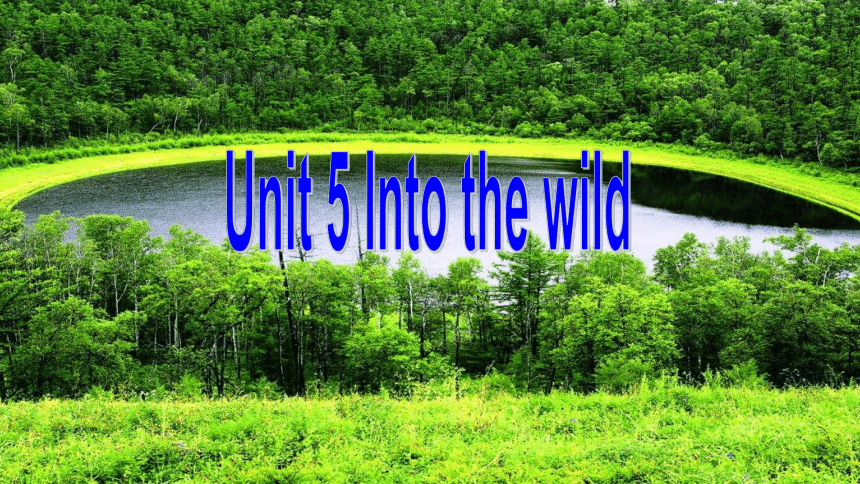
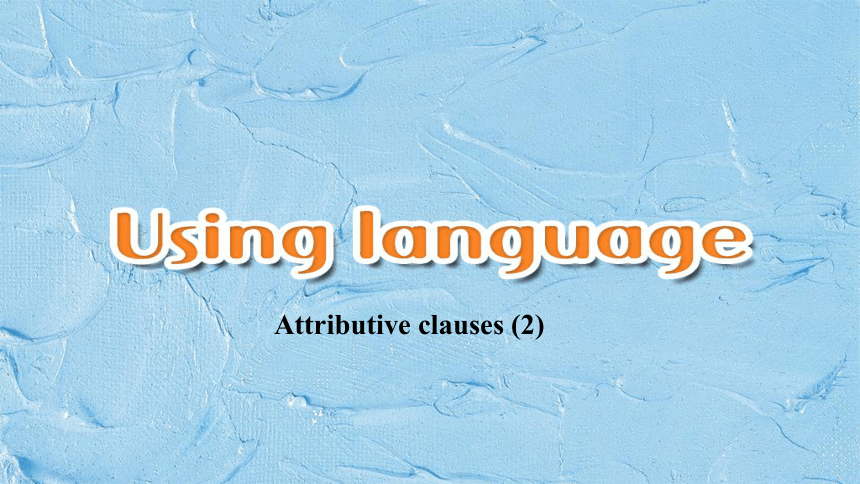
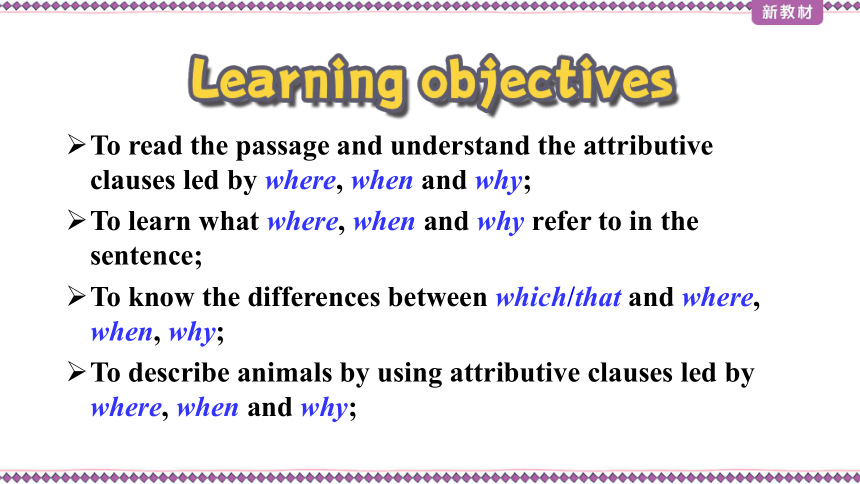
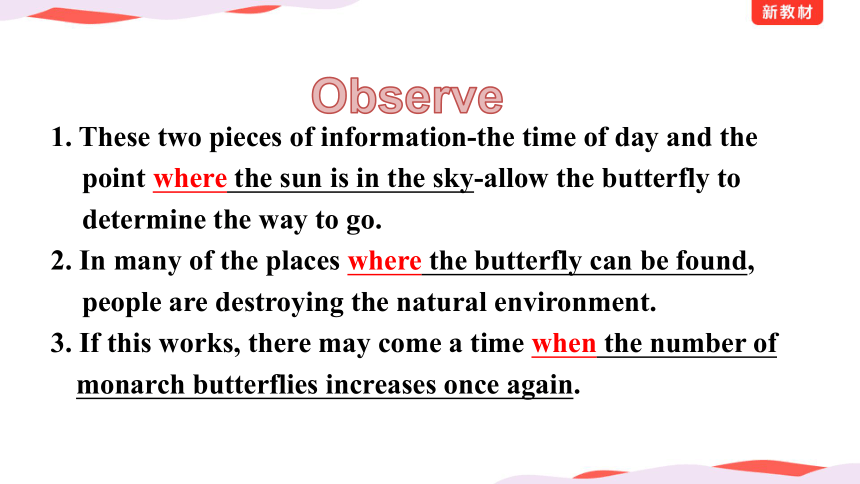

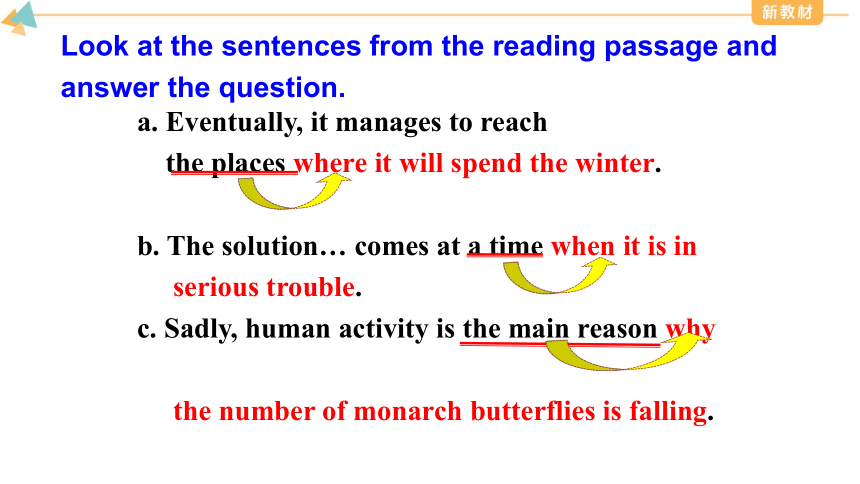

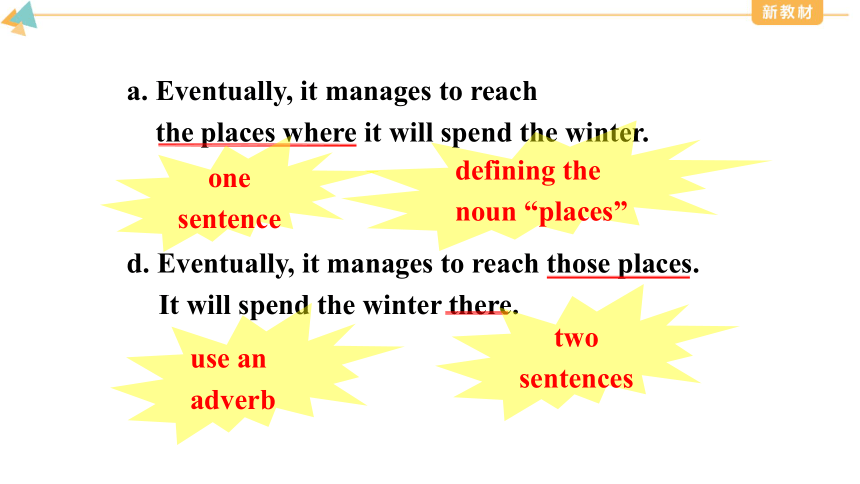
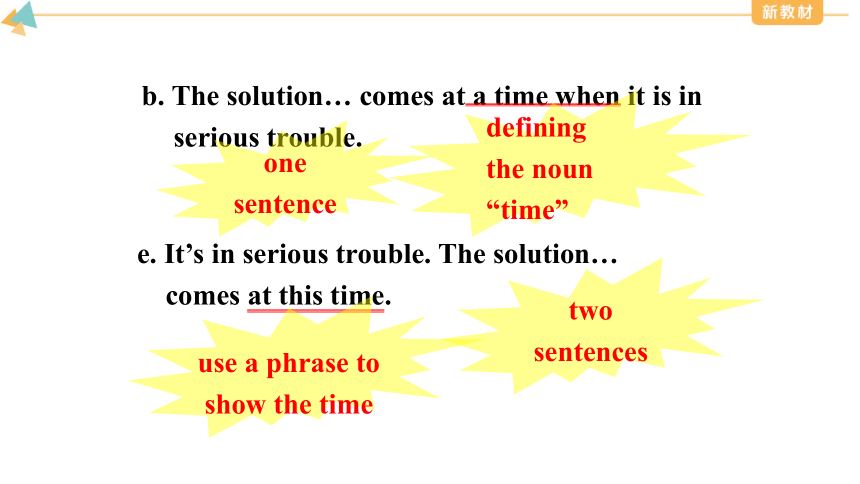

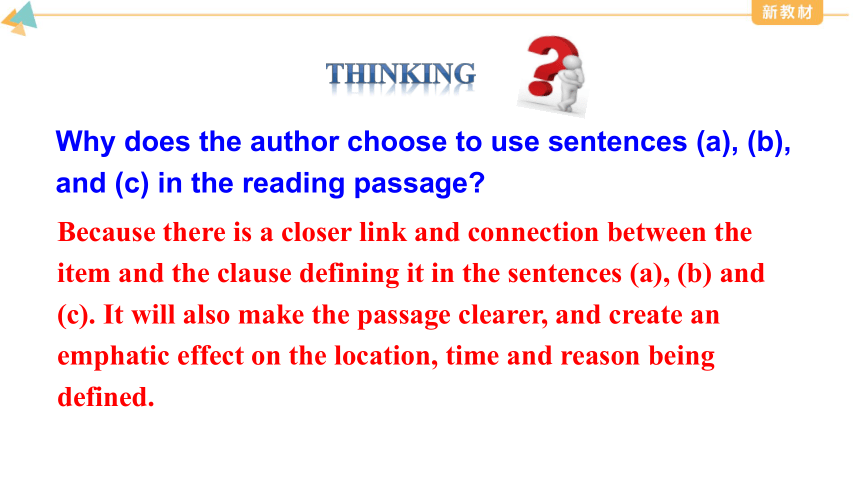
文档简介
(共36张PPT)
Unit 5
Unit 5 Into the wild
Attributive clauses (2)
To read the passage and understand the attributive clauses led by where, when and why;
To learn what where, when and why refer to in the sentence;
To know the differences between which/that and where, when, why;
To describe animals by using attributive clauses led by where, when and why;
1. These two pieces of information-the time of day and the point where the sun is in the sky-allow the butterfly to determine the way to go.
2. In many of the places where the butterfly can be found, people are destroying the natural environment.
3. If this works, there may come a time when the number of monarch butterflies increases once again.
Observe
Analyze sentences from the passage and find out what the words where, when and why refer to;
Find out the advantage of using attributive clauses.
Look at the sentences from the reading passage and answer the question.
a. Eventually, it manages to reach
the places where it will spend the winter.
b. The solution… comes at a time when it is in serious trouble.
c. Sadly, human activity is the main reason why
the number of monarch butterflies is falling.
1. What do “where”, “when”. “why” refer to in each sentences
“Where” refers to “the places” in sentence (a), “when” refers to “a time” in sentence (b) and “why” refers to “the main reason” in sentence (c).
2. What’s the difference between the two groups of sentences
Sentences (a), (b) and (c) contain a clause defining a noun or pronoun in the sentence. Sentences (d), (e) and (f) are constructed with a pair of simple sentences, with one defining a noun or pronoun in the other sentence in each pair.
d. Eventually, it manages to reach those places. It will spend the winter there.
a. Eventually, it manages to reach
the places where it will spend the winter.
one sentence
two sentences
defining the noun “places”
use an adverb
b. The solution… comes at a time when it is in serious trouble.
e. It’s in serious trouble. The solution…
comes at this time.
one sentence
two sentences
defining the noun “time”
use a phrase to show the time
c. Sadly, human activity is the main reason why the number of monarch butterflies is falling.
f. Sadly, human activity is the main reason.
For this reason, the number of monarch butterflies is falling.
one sentence
two sentences
use a phrase
defining the noun “reason”
Why does the author choose to use sentences (a), (b), and (c) in the reading passage
thinking
Because there is a closer link and connection between the item and the clause defining it in the sentences (a), (b) and (c). It will also make the passage clearer, and create an emphatic effect on the location, time and reason being defined.
More practice for what the words where, when and why refer to;
Compare attributive clauses led by which/that with the ones led by where, when or why;
2) In many of the places where the butterfly can be found, people are destroying …
Look for more sentences with attributive clauses in the reading passage.
1) These two pieces of information – the time
of day and the point where the sun is in the sky…
先行词
Where在从句中作地点状语
3) They cut down trees and use chemicals that kill the plants that monarch caterpillars eat.
4) If this works, there may come a time when the number of monarch butterflies may increases once again.
Read the passage and underline the words that where, when, and why refer to.
当引导定语从句的关系词在从句中用作时间、地点、原因状语时,应使用关系副词when, where, why或“介词+which”。
1. 关系副词的作用如下:(1)指代表示时间、地点、原因的先行词;(2)在从句中充当句子成分—状语,即在从句中起副词的作用;(3)起连接作用,把主句和定语从句连接起来构成主从复合句。
关系副词引导的定语从句
2. when, where, why引导的定语从句
(1)when引导定语从句的用法
①当先行词是表示时间的名词(如time, day, year, month, week等),且关系词在从句中作时间状语时,定语从句用when引导。
② when可以换成“介词+which”。
eg I still remember the time when (=in which) I was in college.
【注意】
当先行词是表示时间的名词时,既可以用when引导定语从句,也可以用that或which引导定语从句,关键要看关系词在定语从句中做何种成分。基关系词在定语从句中充当状语,则用when引导;若关系词在定语从句中充当主语或宾语,则用that或which引导。
eg Do you still remember the days (that/ which) we spent together on the farm (that或which作spent的宾语)
Do you still remember the days when we chatted with each other all night (when在从句中作状语)
(2) where引导定语从句的用法
① 当先行词是表示具体地点的名词(如place, room, mountain, airport等)或抽象地点的名词(如case, state, condition, point, situation等),且关系词在从句中作地点状语时,定语从句用where引导。
eg We have reached a point where a change is needed.
He gets into a situation where it is hard to decide what is right or wrong.
② where可以换成“介词+which”。
eg This is the hotel where (=in which) they stayed.
【注意】
当先行词为地点名词时,如果指代先行词的关系词在定语从句中作主语或宾语,则用that或which引导定语从句。
eg His father works in a factory which / that makes radio parts.
(3) why引导定语从句的用法
① 当先行词是表示原因的名词reason, 且引导词在从句中作原因状语时,定语从句用why引导,且只能引导限制性定语从句。
② why可以用for which来代替。
eg This is the reason why (=for which) he left in a hurry.
【注意】
或代替先行词reason的关系词在定语从句中不作状语,而充当主语或宾语时,则用that或which来引导定语从句。
eg The reason that he told me yesterday is a lie.
3. 关系代词与关系副词的选择
定语从句的引导词用关系代词还是关系副词可以用以下两种方式判断:
用法 依据
根据从句的谓语动词 是及物动词,后面若无宾语,用关系代词;是不及物动词则用关系副词。
根据先行词在从句中所作成分 把先行词放入定语从句中,若作主语或宾语用关系代词;作状语用关系副词。
eg This is the factory where he used to work. (work是不及物动词)
This is the factory (that/ which) I visited last year. (visit是及物动词)
Is this the museum (that/ which) you visited a few days ago (从句缺少宾语)
a. Eventually, it manages to reach the places where it will spend the winter.
Eventually, it manages to reach the places which is warm in winter.
adverbial
subject
Compare the following sentences and find out the different use of which/ that and when.
b. The solution… comes at a time when it is in serious trouble.
The solution… comes at a time which is recorded in the book.
adverbial
subject
c. Sadly, human activity is the main reason why the number of monarch butterflies is falling.
Sadly, human activity is the main reason which the scientist has found in his research.
adverbial
object
When we use which/that to lead an attributive clause, which/that is used as subject or object in the clause.
If we use where, when or why to lead an attributive clause, where, when or why is used as an adverbial in the clause.
Conclusion
Complete sentences with the proper words which/that, where, when or why;
Use attributive clauses to describe an animal.
We have known the use of which/that, where, when and why. When we choose the proper word, we should first analyze the attributive clause’s sentence structure.
From: David Waters To: Kay Silverman
Subject: Back to nature
Hi Kay,
We’re having an amazing time here in South Africa. Our accommodation is perfect. It is in a location _______ we can watch animals wandering past on their way to the waterhole.
where
Complete the email with where, when or why.
Sunset is the time of day _______ we sit on the balcony and count how many giraffes or antelopes we can see.
I guess this is the reason _______ this place is so popular. Next week, we are going to fly up to Zambia. That’s one of the countries _______ you can visit the famous Victoria Falls.
See you soon.
David
when
why
where
Write a passage about the experience between you and the animals, and use some attributive clauses in your passage.
Unit 5
Unit 5 Into the wild
Attributive clauses (2)
To read the passage and understand the attributive clauses led by where, when and why;
To learn what where, when and why refer to in the sentence;
To know the differences between which/that and where, when, why;
To describe animals by using attributive clauses led by where, when and why;
1. These two pieces of information-the time of day and the point where the sun is in the sky-allow the butterfly to determine the way to go.
2. In many of the places where the butterfly can be found, people are destroying the natural environment.
3. If this works, there may come a time when the number of monarch butterflies increases once again.
Observe
Analyze sentences from the passage and find out what the words where, when and why refer to;
Find out the advantage of using attributive clauses.
Look at the sentences from the reading passage and answer the question.
a. Eventually, it manages to reach
the places where it will spend the winter.
b. The solution… comes at a time when it is in serious trouble.
c. Sadly, human activity is the main reason why
the number of monarch butterflies is falling.
1. What do “where”, “when”. “why” refer to in each sentences
“Where” refers to “the places” in sentence (a), “when” refers to “a time” in sentence (b) and “why” refers to “the main reason” in sentence (c).
2. What’s the difference between the two groups of sentences
Sentences (a), (b) and (c) contain a clause defining a noun or pronoun in the sentence. Sentences (d), (e) and (f) are constructed with a pair of simple sentences, with one defining a noun or pronoun in the other sentence in each pair.
d. Eventually, it manages to reach those places. It will spend the winter there.
a. Eventually, it manages to reach
the places where it will spend the winter.
one sentence
two sentences
defining the noun “places”
use an adverb
b. The solution… comes at a time when it is in serious trouble.
e. It’s in serious trouble. The solution…
comes at this time.
one sentence
two sentences
defining the noun “time”
use a phrase to show the time
c. Sadly, human activity is the main reason why the number of monarch butterflies is falling.
f. Sadly, human activity is the main reason.
For this reason, the number of monarch butterflies is falling.
one sentence
two sentences
use a phrase
defining the noun “reason”
Why does the author choose to use sentences (a), (b), and (c) in the reading passage
thinking
Because there is a closer link and connection between the item and the clause defining it in the sentences (a), (b) and (c). It will also make the passage clearer, and create an emphatic effect on the location, time and reason being defined.
More practice for what the words where, when and why refer to;
Compare attributive clauses led by which/that with the ones led by where, when or why;
2) In many of the places where the butterfly can be found, people are destroying …
Look for more sentences with attributive clauses in the reading passage.
1) These two pieces of information – the time
of day and the point where the sun is in the sky…
先行词
Where在从句中作地点状语
3) They cut down trees and use chemicals that kill the plants that monarch caterpillars eat.
4) If this works, there may come a time when the number of monarch butterflies may increases once again.
Read the passage and underline the words that where, when, and why refer to.
当引导定语从句的关系词在从句中用作时间、地点、原因状语时,应使用关系副词when, where, why或“介词+which”。
1. 关系副词的作用如下:(1)指代表示时间、地点、原因的先行词;(2)在从句中充当句子成分—状语,即在从句中起副词的作用;(3)起连接作用,把主句和定语从句连接起来构成主从复合句。
关系副词引导的定语从句
2. when, where, why引导的定语从句
(1)when引导定语从句的用法
①当先行词是表示时间的名词(如time, day, year, month, week等),且关系词在从句中作时间状语时,定语从句用when引导。
② when可以换成“介词+which”。
eg I still remember the time when (=in which) I was in college.
【注意】
当先行词是表示时间的名词时,既可以用when引导定语从句,也可以用that或which引导定语从句,关键要看关系词在定语从句中做何种成分。基关系词在定语从句中充当状语,则用when引导;若关系词在定语从句中充当主语或宾语,则用that或which引导。
eg Do you still remember the days (that/ which) we spent together on the farm (that或which作spent的宾语)
Do you still remember the days when we chatted with each other all night (when在从句中作状语)
(2) where引导定语从句的用法
① 当先行词是表示具体地点的名词(如place, room, mountain, airport等)或抽象地点的名词(如case, state, condition, point, situation等),且关系词在从句中作地点状语时,定语从句用where引导。
eg We have reached a point where a change is needed.
He gets into a situation where it is hard to decide what is right or wrong.
② where可以换成“介词+which”。
eg This is the hotel where (=in which) they stayed.
【注意】
当先行词为地点名词时,如果指代先行词的关系词在定语从句中作主语或宾语,则用that或which引导定语从句。
eg His father works in a factory which / that makes radio parts.
(3) why引导定语从句的用法
① 当先行词是表示原因的名词reason, 且引导词在从句中作原因状语时,定语从句用why引导,且只能引导限制性定语从句。
② why可以用for which来代替。
eg This is the reason why (=for which) he left in a hurry.
【注意】
或代替先行词reason的关系词在定语从句中不作状语,而充当主语或宾语时,则用that或which来引导定语从句。
eg The reason that he told me yesterday is a lie.
3. 关系代词与关系副词的选择
定语从句的引导词用关系代词还是关系副词可以用以下两种方式判断:
用法 依据
根据从句的谓语动词 是及物动词,后面若无宾语,用关系代词;是不及物动词则用关系副词。
根据先行词在从句中所作成分 把先行词放入定语从句中,若作主语或宾语用关系代词;作状语用关系副词。
eg This is the factory where he used to work. (work是不及物动词)
This is the factory (that/ which) I visited last year. (visit是及物动词)
Is this the museum (that/ which) you visited a few days ago (从句缺少宾语)
a. Eventually, it manages to reach the places where it will spend the winter.
Eventually, it manages to reach the places which is warm in winter.
adverbial
subject
Compare the following sentences and find out the different use of which/ that and when.
b. The solution… comes at a time when it is in serious trouble.
The solution… comes at a time which is recorded in the book.
adverbial
subject
c. Sadly, human activity is the main reason why the number of monarch butterflies is falling.
Sadly, human activity is the main reason which the scientist has found in his research.
adverbial
object
When we use which/that to lead an attributive clause, which/that is used as subject or object in the clause.
If we use where, when or why to lead an attributive clause, where, when or why is used as an adverbial in the clause.
Conclusion
Complete sentences with the proper words which/that, where, when or why;
Use attributive clauses to describe an animal.
We have known the use of which/that, where, when and why. When we choose the proper word, we should first analyze the attributive clause’s sentence structure.
From: David Waters To: Kay Silverman
Subject: Back to nature
Hi Kay,
We’re having an amazing time here in South Africa. Our accommodation is perfect. It is in a location _______ we can watch animals wandering past on their way to the waterhole.
where
Complete the email with where, when or why.
Sunset is the time of day _______ we sit on the balcony and count how many giraffes or antelopes we can see.
I guess this is the reason _______ this place is so popular. Next week, we are going to fly up to Zambia. That’s one of the countries _______ you can visit the famous Victoria Falls.
See you soon.
David
when
why
where
Write a passage about the experience between you and the animals, and use some attributive clauses in your passage.
